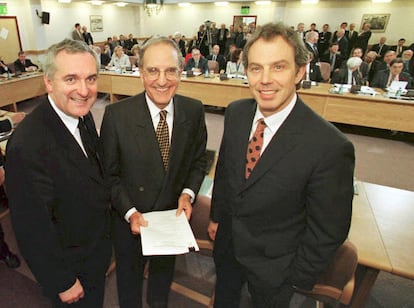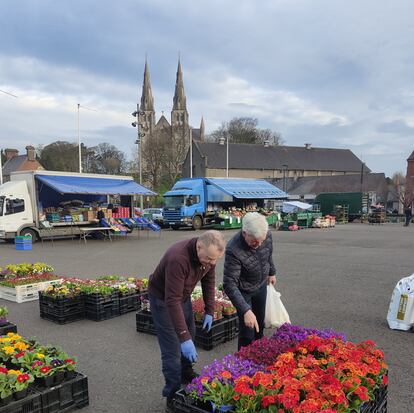Northern Ireland celebrates 25 years of peace amid Brexit instability
The Good Friday Agreement brought an end to three decades of violence during The Troubles, an era that the new generation is eager to consign to history

In the small town of Armagh, near the border that separates Northern Ireland from the Republic of Ireland, there are two cathedrals dedicated to St. Patrick, the patron saint of Ireland, which regard each other from their respective hills with mutual suspicion after 25 years of peace and amnesia. Two signs direct visitors in the direction of one or the other: Cathedral (COI) and Cathedral (RC), denoting the cathedral of the Church of Ireland (Anglican) and the Roman Catholic cathedral.
The heart of Irish Christianity has just over 16,000 of Northern Ireland’s total population of just over 1.9 million inhabitants. During the three decades of The Troubles, which claimed 3,488 lives, 86 people were killed in Armagh. April 10 marks the 25th anniversary of the Good Friday Agreement, or the Belfast Agreement, as the protestant population prefers to call it, which brought an end to some 30 years of sectarian violence.
“There are still some wounds between the two communities that need to heal. Every family has stories of someone who was shot or killed by the other side, and that pain is still felt. It needs to be healed on both sides. But we didn’t live through that experience. For me, sometimes, it’s like something out of a movie. It doesn’t feel like it was real, because today we don’t feel it’s real at all,” says Ben. The 23-year-old opened Café Soujourn a few months ago, a small, tastefully decorated place offering various types of coffee and freshly made croissants.
“It’s a good place to live, with quite a few car dealerships, good housing and a lot of schools,” says Matthew, 22, who works in a local wine shop and says that “luckily, in my case,” he has no memory of The Troubles. His father enlisted in the British army and patrolled the region during the years of conflict. In those days, a road on the southern outskirts of the town was considered so dangerous that it was dubbed “murder mile” by the Royal Ulster Constabulary (RUC). Members of the Irish Republican Army (IRA) moved freely around the rural, winding terrain close to the Republic’s border. British soldiers traversed the area by helicopter. Moving overland was too risky. There were ironic signs on the road that read “Sniper at Work,” displaying the silhouette of a hooded man with a machine gun and a raised fist.
“My two children don’t have the slightest memory of it. The eldest was born in 1994, the year the IRA announced the ceasefire,” says Jeffrey — who like many others agrees to speak to EL PAÍS but instinctively refuses to give his surname. “They know what happened, of course, because they have been told about it. But they have no memory of anything… When they tried to kill that policeman in Omagh a few weeks ago everyone was shocked but it reminded me that was what everyday life was like when we were young.”

The incident to which Jeffrey refers took place on February 22 in Omagh, 35 miles from Armagh, when Detective Chief Inspector John Caldwell, who was off-duty, was shot and seriously wounded while loading soccer balls into his car after a coaching session with a local youth team. Following the shooting, 15 people were arrested. Investigators believe the gunmen were linked to the New IRA, a continuation of the Real IRA, a splinter group formed in 1997 following the IRA’s ceasefire announcement.
“Of course, there are glimpses of how easy it is to go back; we saw it in that assassination attempt,” says notes Sandra Peake, executive director of WAVE. The acronym once stood for Widows Against Violence Empower — a group of eight women from both sides of the conflict who lost their partners. Today, it is the largest support organization for victims of violence in Northern Ireland. “It is undeniable that there have been positive changes that have had a profound psychological effect and affected the way people feel. The Good Friday Agreement was a sea change, because the big difficulty for many victims was that so much of what happened was hidden, and only with time has it come to light,” says Peake. “But there are still paramilitary groups operating on both sides that can jeopardize everything that has been achieved.”
Legacy and protocol
Quarter of a century after the Good Friday Agreement, peace appears to have been consolidated. Reconciliation between the two communities, however, has proven more elusive. Two issues — one past and one future — have stirred up the Northern Irish hornet’s nest in recent years. The Conservative government of Boris Johnson promoted the Northern Ireland Troubles (Legacy and Reconciliation) Bill, with which it sought to temper the judicial review of 30 years of violence by granting immunity to defendants on both sides who cooperated with the Independent Commission for Reconciliation and Information Recovery. Clearly intended to protect ex-military personnel facing criminal prosecution for their actions during the years of conflict, the bill has outraged the families of Republican and Protestant victims.
“The Good Friday Agreement was an extraordinary achievement, but also a commitment that must continue to be worked on. Fundamental parts remain to be developed, such as everything related to human rights and equality” says Professor Colin Harvey of the School of Law at Queen’s University Belfast. “The position that the British Government has adopted in everything regarding the legacy [of The Troubles] has been profoundly counterproductive. It hasn’t helped at all. The peace process is guaranteed, but the anti-protocol discourse used in recent years has been profoundly irresponsible.”

Brexit and betrayal
The Northern Ireland Protocol — the treaty signed between London and Brussels to fit the territory into the post-Brexit era — is the issue of the future and the present that has shaken the stability achieved. From the outset, the main Protestant political grouping, the Democratic Unionist Party (DUP), considered the pact to keep Northern Ireland within the EU internal market a betrayal by the British government. Since the pact was signed, the DUP has blocked the autonomous institutions of government in Northern Ireland and employed the “principle of consent” established in the Good Friday Agreement as a tool for exerting pressure. The principle of consent establishes that any political advance must have the backing of the two communities, although elections in recent years have made it clear that there is an emergent “third community” of moderate and unaffiliated voters who are the most affected by the administrative freeze.
“The peace agreement did not resolve a problem that has dragged on for decades: the existence of two communities with opposing ideas about the country to which Northern Ireland belongs. It was hoped that by enforcing peace and guaranteeing the rights of both sides, these existential issues could be set aside for a couple of generations and a more normal society could emerge in that time. And it more or less worked, until Brexit arrived,” says journalist and author Fintan O’Toole, whose book We Don’t Know Ourselves. A Personal History of Ireland Since 1958 provides a reminder that the history of the island is shared by all its inhabitants.
“There was sectarianism and tension, but also a shared space facilitated by the fact that Ireland and the United Kingdom were part of the European Union,” notes O’Toole. “The idea of removing Northern Ireland from the EU against the democratic will of its population [55.8% voted in favor of remaining] has brought all these questions to the surface. It has encouraged the Unionists to return to the crudest British nationalism and the Republicans to respond with greater urgency regarding the future reunification of the island.”
O’Toole and many other observers of the Northern Ireland situation are confident, however, that the Brexit balloon will deflate soon enough and politics will regain the pragmatism needed to bring stability to the region. The United States has also been keeping a close eye on tensions surrounding the protocol in recent years. British Prime Minister Rishi Sunak has apparently managed to redirect the conflict with Brussels via the so-called Windsor Agreement, which has gained the approval of Washington. President Joe Biden, who is of Irish descent, is scheduled to visit Northern Ireland on Tuesday to take part in the anniversary celebrations.
Biden is not expected to travel to Armagh, where the anniversary does not carry the same relevance as it does in Belfast. Neither does there appear to be a great deal of enthusiasm for remembrance. In the Shambles Market, strategically located between the two cathedrals, Kevin, a 60-year-old Catholic, lays out the flowers he has grown for sale. “There will always be people looking for a fight and trying to rekindle old tensions. But in general, everything has changed for the better,” he says. What is his memory of The Troubles? “More than anything, I remember the walk to school. Police checkpoints. Bombs. Shootings. But these are all distant memories now.”
While he lays boxes of flowers out on the floor, a group of boisterous, uniformed schoolchildren pass by on their way to St Patrick’s Grammar School, located next to the Catholic cathedral. There are mixed schools in Armagh to integrate students from both communities but, as in the rest of Northern Ireland, 25 years of peace has not yet brought an end to the “living apart together” mentality.
Sign up for our weekly newsletter to get more English-language news coverage from EL PAÍS USA Edition
Tu suscripción se está usando en otro dispositivo
¿Quieres añadir otro usuario a tu suscripción?
Si continúas leyendo en este dispositivo, no se podrá leer en el otro.
FlechaTu suscripción se está usando en otro dispositivo y solo puedes acceder a EL PAÍS desde un dispositivo a la vez.
Si quieres compartir tu cuenta, cambia tu suscripción a la modalidad Premium, así podrás añadir otro usuario. Cada uno accederá con su propia cuenta de email, lo que os permitirá personalizar vuestra experiencia en EL PAÍS.
¿Tienes una suscripción de empresa? Accede aquí para contratar más cuentas.
En el caso de no saber quién está usando tu cuenta, te recomendamos cambiar tu contraseña aquí.
Si decides continuar compartiendo tu cuenta, este mensaje se mostrará en tu dispositivo y en el de la otra persona que está usando tu cuenta de forma indefinida, afectando a tu experiencia de lectura. Puedes consultar aquí los términos y condiciones de la suscripción digital.
More information
Archived In
Últimas noticias
Maduro pleads not guilty before the federal court in New York: ‘I am still the president of Venezuela’
A new test can detect Alzheimer’s from a finger prick
UN team enters Sudanese city of El Fasher after paramilitary massacre: ‘It’s like a ghost town’
A recipe for resistance: Indigenous peoples politicize their struggles from the kitchen
Most viewed
- Gilles Lipovetsky: ‘If you want to live better and fall in love, take Prozac, don’t look to philosophy’
- Alain Aspect, Nobel laureate in physics: ‘Einstein was so smart that he would have had to recognize quantum entanglement’
- Alvin Hellerstein, a 92-year-old judge appointed by Bill Clinton, to preside over Maduro’s trial in New York
- Why oil has been at the center of Venezuela-US conflicts for decades
- Maduro’s downfall puts China’s relationship with Venezuela to the test











































